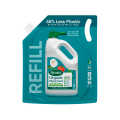Whether it’s a lime tree in the back corner or a blueberry in the front garden, planting fruiting trees is its own reward.
Plant them as hedges, or use them as feature trees in your garden. They will provide you with delicious home-grown fruit, and bring ornamental value to the garden too.
Growing your own orchard is easy. Here’s the five most important things to consider when starting a home grown orchard:
- Location of fruit trees
- Preparing the soil
- Planting fruit trees
- Staking fruit trees correctly
- Maintaining and watering fruit trees
Growing fruit tree basics
Give your fruit trees the best possible start and you’ll be rewarded with strong, healthy, productive trees.
Here are our top tips for growing an orchard at home:
Choosing the right location
Most edible plants require at least six hours of sunlight per day.
- Watch your backyard throughout the day to ensure you select an area with adequate light.
- Remember that the sun is lower in the sky in Winter and the shadows will be different to Summer. Try to position your fruit trees so they receive year-round sunlight.
Preparing the soil
To ensure fruit trees establish well, you need to prepare the soil for planting.
- Dig a hole much larger than you need, to allow the roots to spread effortlessly through the soil.
- Improve the soil (and your trees' health and growth) with organic matter like Scotts Performance Naturals™ Soil Improver
Staking a fruit tree
Staking is an important part of planting fruit trees.
- Hammer in a stake either side of the tree (at least 30-40cm from the trunk), being careful to avoid the bulk of roots.
- Put stakes in at planting to minimise root disturbance later and to provide plants with much needed support while their roots establish in the soil.
- Use a 'figure 8' to loosely tie the tree in place, allowing a little movement while still providing good support.
- Use rubber or wide soft material to minimise damage to the main trunk through rubbing.
Maintaining new fruit trees
Caring for newly planted fruit trees is the same, regardless of which planting method you use.
- Apply Scotts Performance Naturals™ All Purpose Organic Based Fertiliser when new shoots and leaves appear in Spring and repeat in Autumn.
- Water regularly, especially while trees are establishing and fruiting. Automatic irrigation systems are usually the best as fruit trees prefer a regular supply of water.
- Prune regularly to keep trees compact and easier to harvest.
- Spread bird netting over trees as soon as fruit begins to develop (not usually needed for citrus).
- Check for signs of pests and diseases and treat accordingly.
Planting deciduous or evergreen fruit trees
Fruit trees may be planted in one or other of two ways and at two different times of the year, depending on whether they are deciduous or evergreen.
Bare root (deciduous) fruit trees:
Bare rooted fruit trees are available in winter when they have no leaves and are dormant. They are no potted - instead, the roots are clean and may be either completely bare or covered in moist sawdust and wrapped in plastic or hessian.
This is the most common way to buy deciduous fruits trees like apples, pears, plums, peaches and nectarines.
Bare root fruit trees are often less expensive and faster to establish than potted trees.
- Prepare the soil and dig your planting hole.
- Create a small mound into the centre of the planting hole so you can spread the roots of your fruit tree out evenly.
- Make sure the graft or bud union (where the fruit variety has been grafted on to the rootstock) is well clear of the soil.
- Check the final depth (refer to the soil mark that will be clearly visible on the trunk) and carefully hammer in a stake either side of the tree, making sure you don't damage the roots.
- Backfill then carefully firm the soil around and over the roots.
Potted fruit and citrus trees
Potted fruit and citrus trees can be planted out at any time of the year. They are available in pots all year round.
Autumn and Spring are usually the best times to transplant them into the garden - avoid planting in Summer when it's too hot or in winter when growth is minimal.
- Dig a hole slightly larger than the pot and position the plant so that the top of the potting mix is level with the surrounding soil.
- Hammer in a couple of stakes (one either side of the root ball), and backfill. Press the soil down firmly to make sure the tree is secure.
- Water your fruit and citrus trees well.
Now that you have planted your citrus trees, it is important to take care of them. Follow the tips and tricks here - caring for citrus trees












